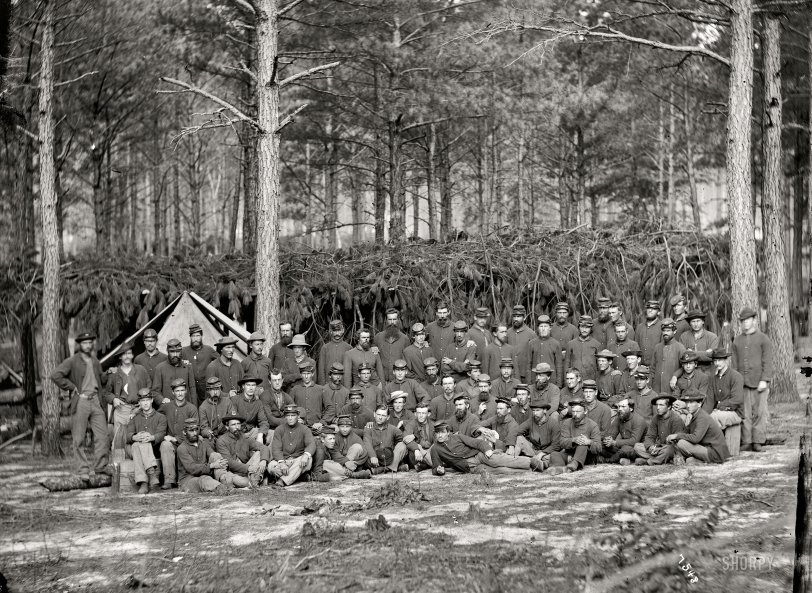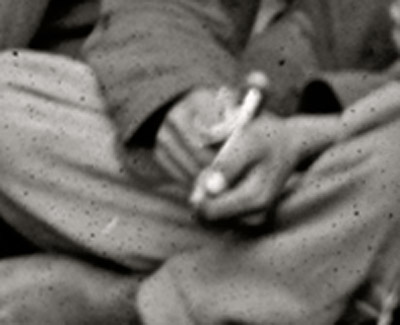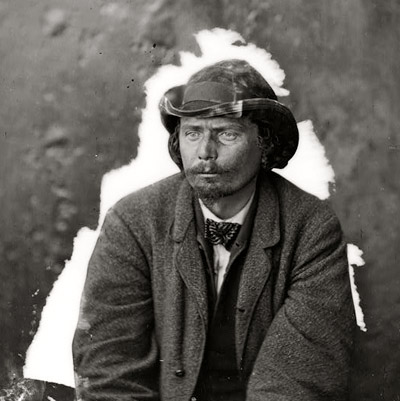


Framed or unframed, desk size to sofa size, printed by us in Arizona and Alabama since 2007. Explore now.
Shorpy is funded by you. Patreon contributors get an ad-free experience.
Learn more.

- Tough Guys
- Lost in Toyland
- And without gloves
- If I were a blindfolded time traveler
- Smoke Consumer Also Cooks
- Oh that stove!
- Possibly still there?
- What?!?
- $100 Reward
- Freeze Frame
- Texas Flyer wanted
- Just a Year Too Soon
- WWII -- Replacing men with women at the railroad crossing.
- Yes, Icing
- You kids drive me nuts!
- NOT An Easy Job
- I wonder
- Just add window boxes
- Icing Platform?
- Indiana Harbor Belt abides
- Freezing haze
- Corrections (for those who care)
- C&NW at Nelson
- Fallen Flags
- A dangerous job made worse
- Water Stop
- Passenger trains have right of way over freights?
- Coal
- Never ceases to amaze me.
- Still chuggin' (in model form)
Print Emporium
Company D: 1864

August 1864. "Group of men of Company D, U.S. Engineer Battalion, in front of Petersburg." Wet plate glass negative, photographer unknown. View full size.
The Long and the Short of It
Those long Irish clay pipes were very common -- made to be broken off shorter and shorter as the mouthpiece wears.
Clay Tobacco Pipes by Eric G. Ayto
Whittling away the War (Between the States)
To me, it looks like the guy on the first row, sitting down, second from right, was whittling on a stick with a knife. He was holding the knife in his right hand while using his right thumb as a leveraged brace on the end of the stick that is pointed toward his body. (You can also see what looks like the end of his right thumb on the end of the stick.) He was cutting (whittling) on the stick with a controlled upward "slice" in the direction of his right thumb.
Notice how deftly he was keeping the anchoring thumb on his left hand out of Harm's Way by holding the stick just below the whittling line.
On the expanded "View full size" photo, I think that I can see a slice of wood being whittled off the stick.
Regardless what this soldier in this photo was doing with his hands, the soldier's hands stayed rock steady for several seconds in order to capture a crisp photograph.
Can somebody with Photoshop software tools blow-up (expand) this section and post it to see for sure?
[He has something looped around his finger. - Dave]

Whittling warrior...
I think the aforementioned guy in the front holding a pipe-like object is actually whittling a piece of wood with a pocketknife... he may even making a pipe. Hell, I would. Everyone else has 'em.
Clay pipes
I can't really tell from the picture but I know that in revolutionary times, many places had a "communal" pipe that was made of clay with a really long stem.
When you wanted to use the pipe, you broke a piece off the tip for sanitary purposes. Eventually the pipe would get too small and be thrown out or have a new tip made.
We used to occasionally find bits and pieces of them in my friends garden, as her house was from that time period. Perhaps the tradition continued and that is why he has a long pipe.
Otherwise you know what they say. It isn't the size of the pipe but .......
The decline of the recline?
Actually, people in the front row recline in mass group photos today, too, so they can fit in more rows of heads.
Atzerodt lookalikes
It's interesting to see a few of these men--by my count three--sporting what I call the George Atzerodt look. A good example is the grizzled one sixth from the right in the front row, on the ground.
Atzerodt, of course, was the man assigned to assassinate Vice President Johnson at the same time President Lincoln and Secretary of State Seward were attacked in April, 1865. Curious George sought courage in the bottom of a whiskey bottle instead of making his appointment with destiny, and ended up wandering the streets of D.C. on the fateful night of April 14th. He was arrested and hanged for this troubles anyway.

Forage cap
The bummer's cap and the "regular CW kepi" are the same thing.
Kepi
I think the guy on the back row with the weird hat is actually wearing a "bummer's kepi." This is sort of like a regular CW kepi, but has an elongated crown that allows the top to flop forward like the one in the photo. There appears to be a couple more in the photo, but they are being worn more in regulation fashion. Note also the number of hats with wide brims in these old CW photos. Yankees soon found out that kepis did not offer much protection from our Southern sunshine.
Reclining guy
Why is it that there's a soldier or two in a reclining position in the front of the group in many of these photographs?
Men With and Without Hats
I'm fascinated by the variety of hats in the photo. I guess they took whatever they could find to cover their heads at that point in the war.
Soldierly affection
In our modern military world any misinterpretation of demonstration of male affection could lead to dismissal under "don't ask, don't tell." That's why we don't see this in group military photos. Thousands of trained military personnel, some with Arabic and Farsi language skills for anti-terrorism intelligence have been let go, also many decorated combat fighter pilots. Putting your arm around your buddy has become suspect and risky.
Two-Foot Pipe
How in the hell could he stick that in his pocket when he was in the field fighting?
Reach out and touch someone
In all-male group photos from this era, I'm often struck by how unselfconscious men were about showing physical affection for their pals. If one were to photograph this same group today, there would be few (if any) hands resting on shoulders, and no interlocking arms. Somewhere along the line, the rules governing when men could touch, and under what circumstances, changed. It's really interesting.
Tremendous photo
Never seen a two-foot pipe before. There is some world class beards in this group, too. I also like how the guy in back row, far right wears his hat. This is a great picture, Dave. Thank you.
Put that in your pipe and smoke it
I see at least 5 pipes displayed in this picture (plus some object in the hands of the guy on the first row, second from right). Wonder if they were actually smoking when the photo was taken. Or did holding a pipe in a photo mean something more to these men?
























On Shorpy:
Today’s Top 5